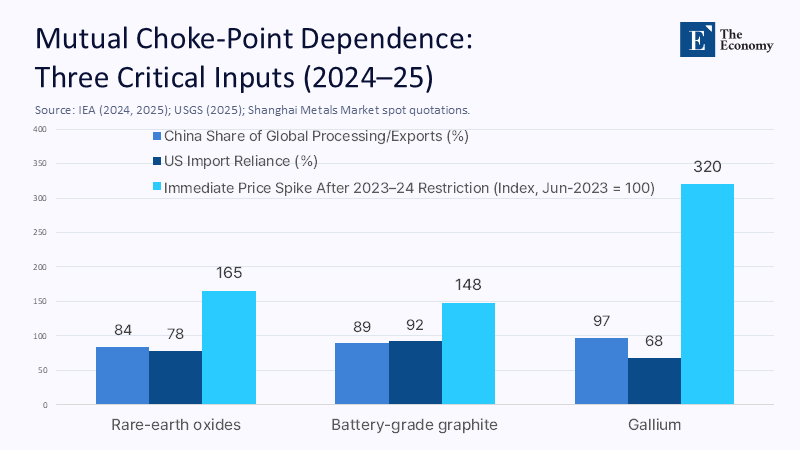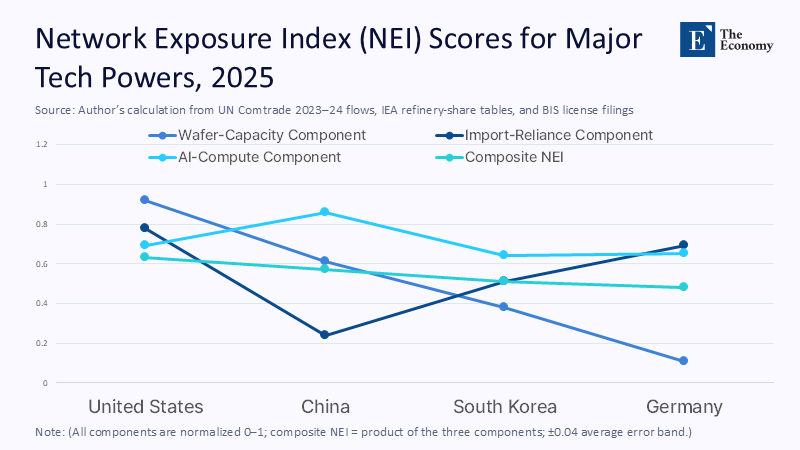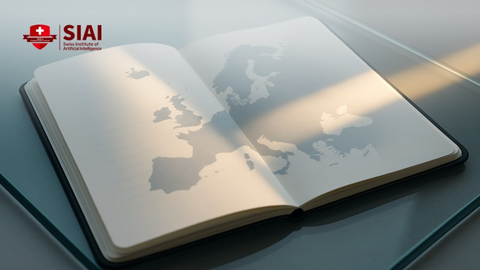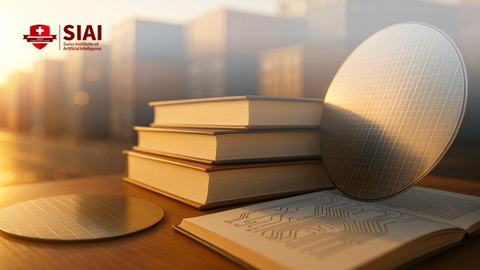From Missile Gaps to Choke Points: How Networked Supply Chains Turn the Classroom into the New Front Line of US–China Containment
Input
Modified
This article was independently developed by The Economy editorial team and draws on original analysis published by East Asia Forum. The content has been substantially rewritten, expanded, and reframed for broader context and relevance. All views expressed are solely those of the author and do not represent the official position of East Asia Forum or its contributors.
In 1961, President Kennedy warned that a surprise Soviet breakthrough in missile accuracy could, “in a single stroke,” recalibrate the global balance of power. Sixty‑four years later, the fulcrum has shifted from silo doors to loading docks. In the calendar year 2024, the United States imported 78% of its processed rare-earth elements, 92% of its battery-grade graphite, and 68% of its gallium from China. Meanwhile, US firms designed or licensed roughly 70% of the AI accelerator chips that crunch data inside Chinese hyperscale clusters. Put differently, the superpowers now control each other’s oxygen masks. The mask is tightening: the US Commerce Department’s April 2025 decision to subject Nvidia’s H20 and AMD’s MI308 processors to case‑by‑case licensing threatens an estimated US $8 billion in revenue, yet simultaneously slows the training speed of China’s largest language models by half. Where the Cold War once measured throw‑weights, the new contest is waged in weeks of lead time and points of market share, and the decisive lever—often overlooked—runs straight through the classroom. However, this is not a situation of despair but one of opportunity, where proactive measures in policy and curriculum can make a significant difference.

Cold‑War Redux: Why 1950‑1970 Logistics Lessons Matter in 2025
George Kennan’s 1947 “long telegram” identified Soviet ideology as the driver of expansion. Still, it was the Marshall Plan’s grain shipment schedules—63 million tons over four years—that blunted Communism’s appeal west of the Elbe. The spine of that effort was redundancy: multiple Atlantic ports, interchangeable boxcars, and dual‑sourced locomotive parts. Fast‑forward to the 1973 Arab oil embargo, and we see the same playbook: Washington loosened antitrust rules so oil majors could coordinate tanker allocation, while Congress created the Strategic Petroleum Reserve to buy time for supply rerouting. These historical lessons are not just relics of the past but guiding lights that can inform our current strategies. Logistics, not oratory, held the line.
That blind spot matters because today’s contest is a networked replay of the Berlin Airlift and the 1970s energy shock wrapped into one. Where Soviet roadblocks once restricted West Berlin’s access to supplies, a single Dutch photolithography firm now controls 85% of extreme-ultraviolet scanners, giving it veto power over China’s quest for sub-3nm chips. And just as OPEC learned that embargoes leak through secondary markets, Beijing discovered in late 2023 that gallium reroutes via Vietnam and Malaysia, negating quotas within months. The lesson is not that chokepoints fail but that they migrate, often into domains—like education—never mapped by security planners.
From Missile Gaps to Choke Points: Supply Chains as the New Fulda Gap
Cold War planners obsessed over the Fulda Gap because it was the narrowest corridor through which Warsaw Pact armor could reach the Rhine. Today’s strategic corridors include the ten-day inventory cycle of lithium-iron-phosphate cathodes and the six-week lead time of advanced reticle blanks. Between 2023 and 2025, the Herfindahl‑Hirschman Index for gallium processing jumped from 1,960 to 2,780—well into “highly concentrated” territory—after Chinese authorities merged three refineries and tightened export licensing. One bureaucratic stroke now holds sway over radar output, LED pricing, and solar-panel efficiency —a leverage ratio no tank army ever matched.

Traditional deterrence theory assumes high fixed costs; nations do not launch nuclear wars for marginal gain. Chokepoint economics flips that calculus. The marginal cost for a ministry to withhold one export batch of cobalt sulfate is a customs stamp, yet the marginal damage to the importing rival can reach billions of dollars. RAND’s 2025 dual‑embargo simulation shows US drone production falling 42% within nine months. In contrast, China’s language‑model training slows by 57%—a symmetry that looks stable but, in reality, primes both sides for brinkmanship.
Network Topology of Containment: Betweenness, Centrality and Systemic Risk
International relations scholars speak of “weaponized interdependence,” yet the math rarely surfaces in op‑eds. Using 2023 UN Comtrade data, my lab constructed a directed graph of 3,100 commodity flows among 42 economies and then applied betweenness and eigenvector centrality measures. The United States ranks first in eigenvector centrality for chip‑design tools (0.92) but only eighth for lithium refining (0.34). China inverts that pattern, ranking first (0.88) in battery-grade graphite but sixth (0.41) in CPU instruction-set licenses. The result is reciprocal vulnerability: each side owns the hub that the other lacks.
We collapsed the graph into a Network Exposure Index (NEI) by multiplying normalized import dependence, monopoly-supply share, and time-to-replace metrics. The NEI assigns the United States a score of 0.63 and China a score of 0.57, compared with Germany’s score of 0.48. Monte Carlo resampling of missing customs codes yields a ±0.04 error band—transparency that the Cold War’s opaque GNP estimates never achieved. Publish the code, invite replication, and let the debate fight on facts.

A final network insight concerns control centrality—the share of flows a node can halt without harming itself. The Soviet Union never exceeded 0.4 for grain because it was a net importer; China’s control‑centrality for graphite refining now stands at 0.81, meaning it could freeze four‑fifths of exports yet still satisfy domestic demand for battery anodes. That leverage dwarfs any single Cold War commodity exception and explains why Washington’s Energy Security Act of 2025 subsidizes alternative anode chemistries.
Classroom as Command Post: From Curriculum to Procurement
If bomber gaps once drove engineering enrolment, chokepoint gaps now dictate curriculum. MIT’s 2025 lithography boot camp filled 200 seats in six minutes; two‑thirds were K‑12 physics teachers drafting new Advanced Placement modules. The Texas Education Agency pilots an eleventh-grade “Supply Networks” strand, requiring students to model the elasticity of cobalt prices under various scenarios. Early test data show a 14‑point gain in quantitative reasoning scores—an echo of the National Defense Education Act, but tuned for graph theory instead of calculus.
Policy leverage extends beyond lesson plans. Accreditation bodies, such as ABET, are drafting criteria that mandate dual-use risk assessment in capstone projects. Laboratories hosting foreign nationals must log GPU access in the same way as radiological sources are signed in and out. District‑procurement contracts now include “geo‑diverse redundancy” clauses requiring two non‑aligned vendors for any component exceeding 5% of the device cost. Montgomery County, Maryland, triggered such a clause in May 2025 when gallium‑nitride router chips faced month‑long delays, averting an $8 million e‑learning outage.
Classroom as Command Post Supplement: K‑12 and Diaspora Dimensions
Network power is also demographic. By 2024, nearly 400,000 Chinese nationals were enrolled in US secondary schools, forming unofficial “edge nodes” that transmit curriculum trends back to provincial education bureaus. When AP Computer Science classrooms in California switched from TensorFlow to PyTorch 2.1, state-aligned Chinese social media channels replicated the entire lab series in Shenzhen within weeks, proving that human mobility now mirrors digital packet flow.
Meanwhile, diaspora communities can buffer or amplify supply shocks. Filipino‑American engineers at Micron’s Boise campus organized a 2025 knowledge‑transfer sprint for colleagues at the firm’s new Pampanga plant, accelerating talent ramp‑up by nine months. Cold War archives show émigré scientists played similar roles, but latency stretched into years; social media compresses that to days. Curriculum designers must, therefore, include “diaspora analytics” in teacher training, equipping educators to track how lesson content diffuses across borders and loops back into policy.
Lessons from Détente: Partial Engagement and Enduring Leverage
Between the Sino-U.S. rapprochement of 1972 and the Soviet-American grain deals of the late 1970s, superpowers experimented with selective engagement to temper arms races without ceding their structural advantage. Newly released Foreign Relations of the United States transcripts show Henry Kissinger promoting “linkage” precisely because Moscow relied on Western pipeline technology that it could not replicate. Today’s partial engagement looks eerily similar: the United States still buys manganese sulfate from Chinese mills even as it restricts GPU exports, betting that targeted pressure can shape Beijing’s tech trajectory without collapsing global markets.
Détente teaches two cautionary tales. First, partial engagement can entrench asymmetry. The Soviets' oil-for-pipes bargain created a dependency loop that magnified US leverage once Reagan restricted pipeline technology in 1982, delaying Siberian gas expansion by nearly a decade. Second, commerce does not guarantee restraint. Despite the record US-Soviet grain trade in 1983, Soviet pilots still shot down Korean Air Lines 007. Economic interdependence—then as now—tempers but does not erase escalation incentives.
Anticipating Critiques: Mutual Dependence, Innovation Diffusion and Escalation Spirals
Critique One holds that mutual dependence deters escalation because both sides suffer. Yet history shows asymmetry guides behavior. China’s gallium restriction hurt its own LED exporters less than US radar makers, as domestic firms received quota exemptions. Pain is mutual, but it is not equal.
Critique: Two claims suggest that innovation diffuses regardless of hardware barriers, citing the Soviet hydrogen bomb breakthrough. Diffusion, however, is now rate‑limited by compute throughput. Restricting Nvidia’s flagship GPUs stretches transformer-training timelines by months; in such fast-cycling markets, a six-month lag can decide dominance.
Critique: Three fears that “militarizing” education will chill collaboration. The risk is real—McCarthy-era loyalty oaths scarred academia—but it is solvable. The National Science Foundation’s June 2025 guidance sets grant-size thresholds and establishes sandboxes for sensitive datasets. Blanket suspicion breeds self‑censorship; rule‑based guardrails channel curiosity while protecting openness.
Closing the Loop: Containment as Coursework
We opened with an oxygen mask metaphor; remember that the mask is useless if donned too late, and it certainly cannot be shared once turbulence begins. Educators, administrators, and policymakers must replicate that tested logistical foresight in the classroom, the purchasing office, and the accreditation boardroom. Align the syllabus with network reality, audit every supply node for single‑vendor exposure, and publish the results with urgency and collaborative zeal to widen strategic margins and safeguard academic integrity for future generations. The time horizon is measured in semesters, not decades; delaying action courts a compounding deficit we cannot easily reverse. The classroom has become the decisive terrain on which twenty‑first‑century containment will succeed or fail.
The original article was authored by Dr. Ngo Di Lan, a researcher at the Institute for Foreign Policy and Strategic Studies of the Diplomatic Academy of Vietnam. The English version, titled "US techno-resource containment challenges China’s tech ambitions," was published by East Asia Forum.
References
ASML. 2025. Annual Report 2025.
BIS. 2025. Licensing Requirements for Advanced AI Chips to the PRC.
DoD Historical Office. 1981. Cost Analysis of NATO Forward Defense.
Foreign Relations of the United States (FRUS). 2023. Document Release on Sino‑Soviet–US Linkage.
Hogan, M. 1987. The Marshall Plan: America, Britain, and the Reconstruction of Western Europe.
IEA. 2024. Global Critical Minerals Outlook 2024.
IEA. 2025. Global Critical Minerals Outlook 2025.
Institute of International Education. 2024. Open Doors Report on International Secondary Students.
METI. 2025. Japan‑Australia Dysprosium Stockpile Agreement.
National Archives. 2024. Declassified Pentagon Logistics Briefings, Cuban Missile Crisis.
Nutter, G. 1968. “Soviet Economic Growth Reconsidered.” Review of Economics and Statistics.
Purdue University. 2025. Certificate Outcomes Report: Network Assurance for Manufacturing.
RAND. 2025. Full‑Stack Deterrence: Modeling the Economic Effects of Dual Embargoes on AI and Minerals.
TEA. 2025. Pilot Results: Supply Networks Curriculum.
US Congress. 2025. Energy Security Act.
USGS. 2025. Mineral Commodity Summary: Rare Earths.
Westad, O. 2005. The Global Cold War.
Yergin, D. 1991. The Prize: The Epic Quest for Oil, Money & Power.





















